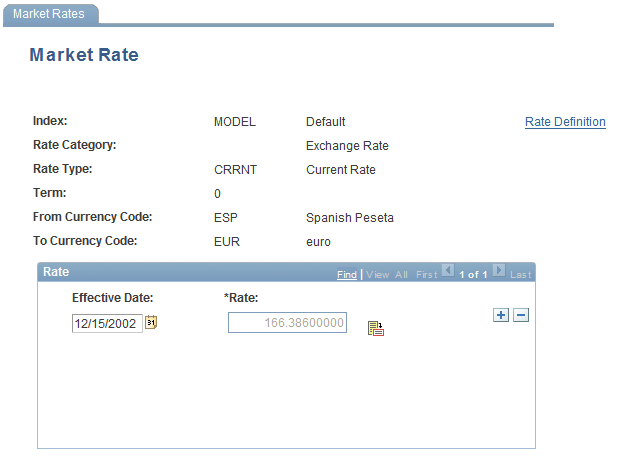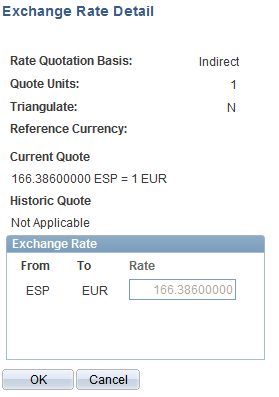Establishing Market Rates for EPM Currency Conversion
PeopleSoft-delivered ETL jobs move market rate data from your source transaction system to EPM target warehouse tables. You need only use the market rate PIA pages to redefine or modify your existing market rate data.
This topic discusses how to:
Define market rates.
Establish rate definitions.
Maintain exchange rates.
Load market rates.
Pages Used to Establish Market Rates for EPM Currency Conversion
|
Page Name |
Definition Name |
Usage |
|
|---|---|---|---|
|
Market Rate |
RT_RATE_PNL |
|
Define market rates. |
|
Rate Definition |
RT_RATE_DEF_SEC |
Click the Rate Definition link on the Market Rates page |
Establish rate definitions. |
|
Exchange Rate Detail |
EXCH_RT_DTL |
Click the Exchange Rate Detail button on the Market Rates page. This page can also be accessed from other pages in the system. |
Maintain exchange rates. |
Market Rate Page
Use the Market Rate page (RT_RATE_PNL) to define market rates.
Image: Market Rates page
This example illustrates the fields and controls on the Market Rates page. You can find definitions for the fields and controls later on this page.

Market rates can be loaded to the RT_RATE_TBL from any external source using the DataStage ETL tool. Use this page to verify that the market rates were loaded correctly.
You can edit the rate for non triangulated rates and for triangulated rates if a quotation method has been defined for the currency pair and the Cross rate Allow Overridecheck box is selected on the Currency Quotation Method page. If an override is not allowed, you can update the exchange rate values to and from the reference currency on the Exchange Rate Detail page.
Changing a Triangulated Cross Rate
If you change a triangulated cross rate, the system recalculates one of the component rates. This can result in the cross rate being recalculated in a manner that is slightly different from the one that you entered. For example, you start with a triangulated rate of RM=6.80000000 and RD=1.25000000 for a cross rate of 5.44000000. If you change the cross rate to 5.43550000:
The system first recalculates RD to 1.25103486.
The system then recalculates the cross rate to 5.43550001 based on the first recalculation.
In rate maintenance, you must accept the recalculation. However, in a situation such as journal entry, a warning message enables you to override triangulation and to use the exact rate that you entered, which results in the rate being stored as RM equal to 5.43550000 and RD equal to 1.
You can edit the Rate field except when all of these conditions are true:
The rate is triangulated.
The primary visual rate is the cross rate.
The Allow Override check box on the Currency Quotation Method page is deselected for the exchange rate's quotation method.
Note: Typically, you do not maintain triangulated exchange rates online. Instead, maintain the rates of the from currency to the reference currency and the reference currency to the to currency, and then run the Cross rate Reciprocal SQR (EO9030.SQR) to define the triangulated exchange rates.
Reciprocal Currency Pairs
If a quotation method has been defined for the currency pair and if the Auto Reciprocate check box is selected, creating or maintaining a rate for a currency pair automatically creates or updates the rate of the reciprocal currency pair. For example, if you change the USD to GBP rate, the GBP to USD rate automatically is automatically updated. You can only automatically reciprocate currency pairs for which quotation methods have been defined.
If a rate definition does not already exist for the currency pair, one will be automatically created with the default values of 2.5 percent maximum variance and warning message processing.
Rate Definition Page
Use the Rate Definition page (RT_RATE_DEF_SEC) to establish rate definitions.
Image: Market Rate - Rate Definition page
This example illustrates the fields and controls on the Market Rate - Rate Definition page. You can find definitions for the fields and controls later on this page.

Note: The results of changing the rate definition do not take effect until you save the Market Rates page.
Click OK to return to the Market Rates page.
Exchange Rate Detail Page
Use the Exchange Rate Detail page (EXCH_RT_DTL) to maintain exchange rates.
Click the Exchange Rate Detail button on the Market Rates page. This page can also be accessed from other pages in the system.
Image: Market Rate - Exchange Rate Detail page
This example illustrates the fields and controls on the Market Rate - Exchange Rate Detail page. You can find definitions for the fields and controls later on this page.

The read-only fields include: